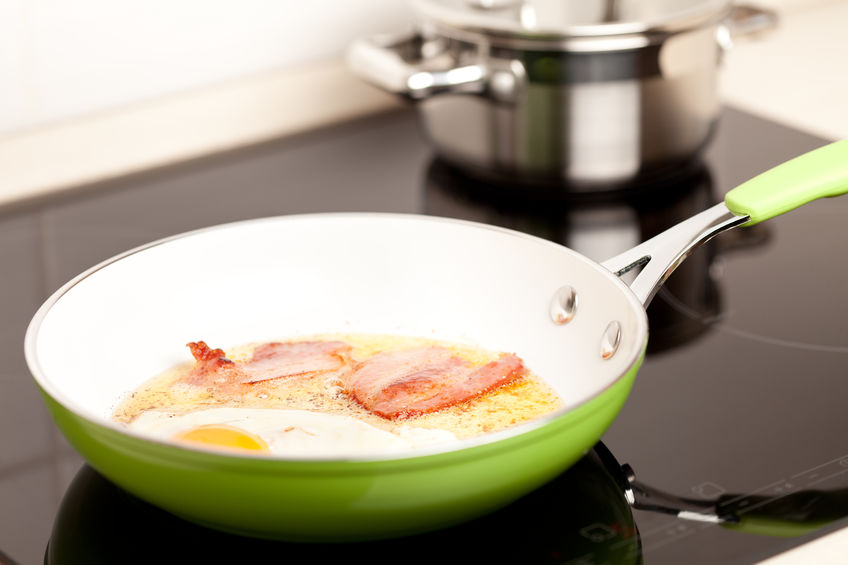
When delving into the realm of cookware, prioritizing safety becomes imperative.
With an extensive array of choices at your disposal, comprehending the potential hazards and advantages linked to various coatings is crucial.
In contemporary times, ceramic coating has emerged as a compelling substitute for the conventional Teflon coating, garnering increased favor among consumers.
This article aims to scrutinize the safety aspects of ceramic coating in comparison to Teflon, unraveling pivotal factors that should guide your decision-making process when faced with the choice between these two popular options.
Understanding Ceramic Coating

Ceramic coating is a specialized layer created from inorganic elements such as silica, oxygen, and minerals.
This coating is meticulously applied onto a metal base, typically aluminum, utilizing techniques like spraying or dipping.
The result is a sleek and resilient coating that not only provides exceptional durability but also furnishes a highly efficient non-stick surface for cooking.
Advantages of Ceramic Coating

Non-toxic
Ceramic coatings are widely acknowledged for their non-toxic nature, devoid of harmful substances like PFOA (perfluorooctanoic acid) and PFAS (per- and poly-fluoroalkyl substances).
Unlike traditional Teflon coatings, which often contain these health-sensitive chemicals, ceramic coatings eliminate the concerns associated with potential adverse effects on human health.
Heat Resistance
Withstanding high temperatures, ceramic coatings exhibit impressive heat resistance, often capable of handling up to 500 degrees Celsius (932 degrees Fahrenheit).
This characteristic ensures their suitability for diverse cooking methods, including oven baking and broiling, without emitting harmful fumes.
Durability
Renowned for their robustness, ceramic coatings resist scratches and abrasions, contributing to their overall durability.
When used and maintained appropriately, cookware with ceramic coatings can endure for an extended period, offering reliable performance in the kitchen.
Examining Teflon Coating

Teflon, also known as polytetrafluoroethylene (PTFE), has been widely used as a non-stick coating for cookware for decades.
However, it has faced criticism due to concerns about its safety.
Potential Risks of Teflon Coating
Chemical emissions
When heated to high temperatures (above 260 degrees Celsius or 500 degrees Fahrenheit), Teflon coatings can release toxic fumes that may cause flu-like symptoms in humans and even harm pet birds.
This phenomenon, known as “Teflon flu” or “polymer fume fever,” occurs when the coating undergoes a process called “pyrolysis.”
Perfluorinated compounds (PFCs)
Teflon coatings have historically been made using PFOA, a chemical that is now being phased out due to its persistence in the environment and potential health risks.
While newer Teflon products claim to be PFOA-free, they may still contain other perfluorinated compounds (PFAS), which have raised similar concerns.
The Safer Choice is Ceramic Coating

While both ceramic and Teflon coatings have their pros and cons, ceramic coating appears to be a safer option overall, primarily due to its non-toxic nature and heat resistance properties.
By choosing ceramic-coated cookware, you can minimize exposure to potentially harmful chemicals and reduce the risk of overheating the coating.
Important Considerations:
Quality matters
When selecting ceramic-coated cookware, it’s essential to opt for reputable brands that adhere to rigorous manufacturing standards.
Lower-quality coatings may contain trace amounts of heavy metals, so thorough research and reading customer reviews can help you make an informed decision.
Proper usage and care
Regardless of the coating type, it is crucial to follow the manufacturer’s instructions for use and maintenance.
Using non-abrasive utensils and avoiding high heat settings can help prolong the lifespan of the coating and maintain its non-stick properties.
An Example of a Popular Ceramic Coating Cookware Set

The GreenLife Soft Grip Ceramic Non-Stick Cookware Set offers a comprehensive collection of pots and pans for your cooking needs.
This 16-piece set includes various sizes of frying pans, saucepans, stockpots, and utensils, all featuring a durable ceramic non-stick coating.
The ceramic coating is free from PFOA, PFAS, lead, and cadmium, ensuring a safe and healthy cooking experience.
The cookware set is made with a sturdy aluminum body that ensures even heat distribution, reducing the chances of hot spots.
The soft-grip handles stay cool to the touch, providing comfort and safety during cooking.
The set is oven safe up to 350 degrees Fahrenheit, allowing for versatile cooking options.
Additionally, the GreenLife Soft Grip cookware set is dishwasher safe, making cleanup a breeze.
Its vibrant turquoise color adds a stylish touch to any kitchen decor.
This cookware set has garnered positive reviews from customers, praising its non-stick performance, ease of use, and durability.
It offers an excellent balance of safety, functionality, and aesthetics, making it a popular choice among ceramic coating enthusiasts.
Bottom Line – Is Ceramic Coating Safer than Teflon?

In the continuous discourse comparing ceramic coating and Teflon, ceramic coating stands out as a more secure option owing to its non-toxic composition and impressive heat-resistant characteristics.
While Teflon coatings have enjoyed extensive use historically, mounting apprehensions regarding chemical emissions and potential health hazards have spurred a growing preference for alternatives prioritizing safety.
Opting for top-tier ceramic-coated cookware, coupled with the adoption of proper usage and maintenance practices, empowers individuals to relish the advantages of non-stick cookware while concurrently mitigating potential risks to both personal health and the environment.


